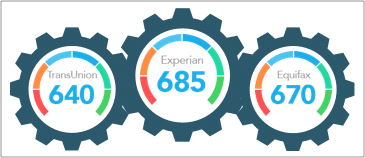When you’re working on your credit, lowering your credit card utilization should be an essential part of your overall strategy. Your credit utilization ratio refers to your actual revolving credit balances compared to your credit limits. The Consumer Financial Protection Bureau recommends keeping your credit utilization on your revolving credit accounts under 30% of your limits, both for each individual account as well as the combined limit of all your revolving accounts. Note: Revolving credit is a type of credit that enables you to borrow against a set limit at any time. You can choose to pay it all off at once or make smaller payments every month and carry or “revolve” the balance. Revolving accounts include credit cards, retail cards, personal lines of credit and home equity lines of credit (HELOCs).
Here are three easy steps you can take today to start lowering your credit utilization.
Pay Down Balances
The most straightforward way to reduce your credit utilization (although not always the easiest) is to pay down your balances. In an ideal scenario, you would pay off your balance in full each month. But if you’re starting off with high credit card balances, start paying more than the minimum amount due.
Instead of aggressively paying down your balances randomly, however, strategically choose the cards that are closest to maxed out. They’re the ones with the highest credit utilization ratio.
Your goal should be to get each balance below 30% of the card’s limit. Here’s how that looks:
Say you have two credit cards, one with a $5,000 credit limit and one with a $10,000 credit limit. Your outstanding balance on each card is $2,500.
Even though the balances are identical, your credit utilization for the card with a $5,000 limit is 50%, while it’s only 25% for the card with the $10,000 limit. In order to reduce your credit utilization ratio, you would focus your extra payments on the first card until your balance reached $1,500 (the 30% mark) or less.
Ask for a Line of Credit Increase
As you work on making extra credit card payments, you can also ask for an increase on your existing line of credit. Looking at the example above, receiving an additional $2,500 to your credit limit on the $5,000 card would automatically bring down your credit utilization ratio.
Of course, this tactic should be used only by people who can responsibly manage their spending. If you receive a higher credit limit and immediately start spending, you may find yourself right back in the same credit utilization ratio situation as before. Keep in mind that your creditor may choose to check your credit before approving you for a higher limit. This could result in a new credit inquiry that may lower your score five to 10 points in the short term.
Avoid Closing Credit Cards
When you finally pay off some debt, don’t close your existing credit cards, especially if you have balances on other accounts. If you do, you’ll increase your credit utilization. That’s because you’re limiting your total available credit. Unless you’re paying expensive annual fees on your credit cards, in most cases having credit cards with no balances is better for your credit. You may need to make a small purchase periodically in order to keep the cards active.
How Often Does Your Credit Utilization Update?
Even after you figure out how to lower your credit utilization, the changes you make don’t register on your credit report or credit score overnight. It takes time for a creditor to report the updated balance information to each of the three major credit bureaus. In most cases, expect to see a difference in your score within 30 to 45 days.




